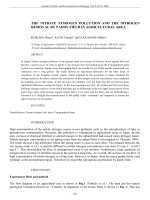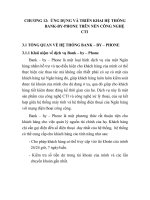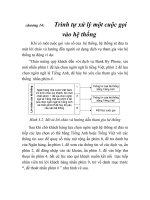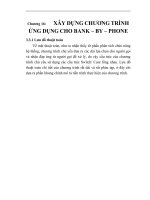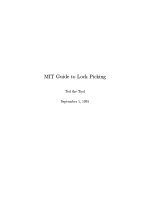The Number Concept, by Levi Leonard Conant docx
Bạn đang xem bản rút gọn của tài liệu. Xem và tải ngay bản đầy đủ của tài liệu tại đây (1.24 MB, 629 trang )
The Project Gutenberg EBook of The Number
Concept, by Levi Leonard Conant
This eBook is for the use of anyone
anywhere at no cost and with
almost no restrictions whatsoever. You may
copy it, give it away or
re-use it under the terms of the Project
Gutenberg License included
with this eBook or online at
www.gutenberg.net
Title: The Number Concept
Its Origin and Development
Author: Levi Leonard Conant
Release Date: August 5, 2005 [EBook
#16449]
Language: English
*** START OF THIS PROJECT GUTENBERG EBOOK
THE NUMBER CONCEPT ***
Produced by Jonathan Ingram, Hagen von
Eitzen and the
Online Distributed Proofreading Team at
THE MACMILLAN COMPANY
NEW YORK · BOSTON · CHICAGO · DALLAS
ATLANTA · SAN FRANCISCO
MACMILLAN & CO., Limited
LONDON · BOMBAY · CALCUTTA
MELBOURNE
THE MACMILLAN COMPANY
OF CANADA, Limited
TORONTO
THE NUMBER
CONCEPT
ITS ORIGIN AND DEVELOPMENT
by
LEVI LEONARD CONANT, Ph.D.
ASSOCIATE PROFESSOR OF MATHEMATICS IN
THE WORCESTER
POLYTECHNIC INSTITUTE
New York
MACMILLAN AND CO.
AND LONDON
1931
Copyright, 1896,
By THE MACMILLAN COMPANY.
Copyright, 1924,
By EMMA B. CONANT.
All rights reserved—no part of this book
may be reproduced in any form without
permission in writing from the publisher.
Set up and electrotyped. Published July,
1896.
Norwood Press
J. S. Cushing Co.—Berwick & Smith Co.
Norwood, Mass., U.S.A.
In the selection of authorities which
have been consulted in the preparation of
this work, and to which reference is made
in the following pages, great care has been
taken. Original sources have been drawn
upon in the majority of cases, and nearly
all of these are the most recent attainable.
Whenever it has not been possible to cite
original and recent works, the author has
quoted only such as are most standard and
trustworthy. In the choice of orthography
of proper names and numeral words, the
forms have, in almost all cases, been
written as they were found, with no
attempt to reduce them to a systematic
English basis. In many instances this
would have been quite impossible; and,
even if possible, it would have been
altogether unimportant. Hence the forms,
whether German, French, Italian, Spanish,
or Danish in their transcription, are left
unchanged. Diacritical marks are omitted,
however, since the proper key could
hardly be furnished in a work of this kind.
With the above exceptions, this study
will, it is hoped, be found to be quite
complete; and as the subject here
investigated has never before been treated
in any thorough and comprehensive
manner, it is hoped that this book may be
found helpful. The collections of numeral
systems illustrating the use of the binary,
the quinary, and other number systems,
are, taken together, believed to be the
most extensive now existing in any
language. Only the cardinal numerals have
been considered. The ordinals present no
marked peculiarities which would, in a
work of this kind, render a separate
discussion necessary. Accordingly they
have, though with some reluctance, been
omitted entirely.
Sincere thanks are due to those who
have assisted the author in the preparation
of his materials. Especial
acknowledgment should be made to
Horatio Hale, Dr. D. G. Brinton, Frank
Hamilton Cushing, and Dr. A. F.
Chamberlain.
Worcester, Mass., Nov. 12, 1895.
CONTENTS.
CHAPTER I.
Counting 1
CHAPTER II.
Number System Limits 21
CHAPTER III.
Origin of Number Words 37
CHAPTER IV.
Origin of Number Words (continued)
74
CHAPTER V.
Miscellaneous Number Bases 100
CHAPTER VI.
The Quinary System 134
CHAPTER VII.
The Vigesimal System 176
THE NUMBER
Index 211
CONCEPT: ITS
ORIGIN AND
DEVELOPMENT.
CHAPTER I.
COUNTING.
Among the speculative questions which
arise in connection with the study of
arithmetic from a historical standpoint, the
origin of number is one that has provoked
much lively discussion, and has led to a
great amount of learned research among
the primitive and savage languages of the
human race. A few simple considerations
will, however, show that such research
must necessarily leave this question
entirely unsettled, and will indicate
clearly that it is, from the very nature of
things, a question to which no definite and
final answer can be given.
Among the barbarous tribes whose
languages have been studied, even in a
most cursory manner, none have ever been
discovered which did not show some
familiarity with the number concept. The
knowledge thus indicated has often proved
to be most limited; not extending beyond
the numbers 1 and 2, or 1, 2, and 3.
Examples of this poverty of number
knowledge are found among the forest
tribes of Brazil, the native races of
Australia and elsewhere, and they are
considered in some detail in the next
chapter. At first thought it seems quite
inconceivable that any human being should
be destitute of the power of counting
beyond 2. But such is the case; and in a
few instances languages have been found
to be absolutely destitute of pure numeral
words. The Chiquitos of Bolivia had no
real numerals whatever,
1
but expressed
their idea for “one” by the word etama,
meaning alone. The Tacanas of the same
country have no numerals except those
borrowed from Spanish, or from Aymara
or Peno, languages with which they have
long been in contact.
2
A few other South
American languages are almost equally
destitute of numeral words. But even here,
rudimentary as the number sense
undoubtedly is, it is not wholly lacking;
and some indirect expression, or some
form of circumlocution, shows a
conception of the difference between one
a nd two, or at least, between one and
many.
These facts must of necessity deter the
mathematician from seeking to push his
investigation too far back toward the very
origin of number. Philosophers have
endeavoured to establish certain
propositions concerning this subject, but,
as might have been expected, have failed
to reach any common ground of agreement.
Whe w e l l has maintained that “such
propositions as that two and three make
five are necessary truths, containing in
them an element of certainty beyond that
which mere experience can give.” Mill,
on the other hand, argues that any such
statement merely expresses a truth derived
from early and constant experience; and in
this view he is heartily supported by
Tylor.
3
But why this question should

